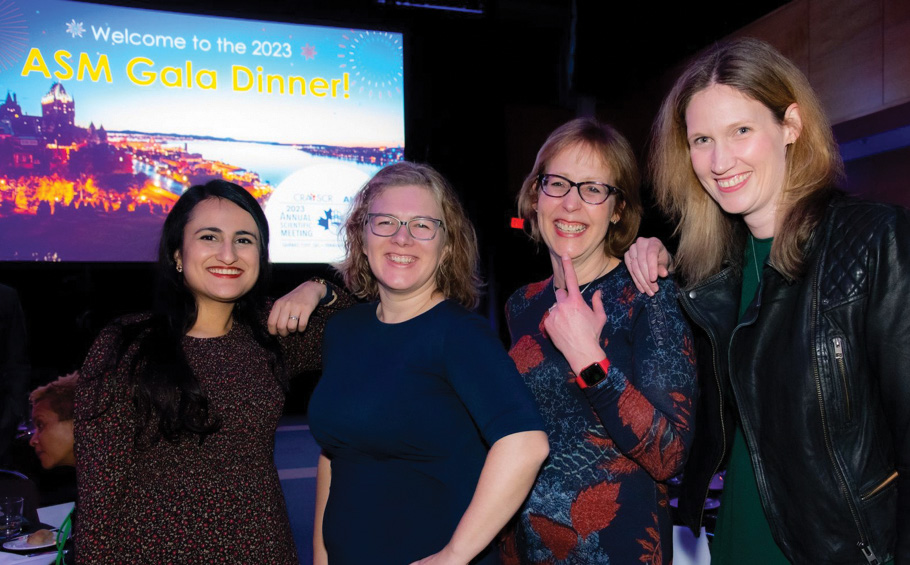Spring 2023 (Volume 33, Number 1)
Reconnecting, Renewing, and
Reimagining:
Perspectives on Burnout
By Stephanie Garner, MD, MSc, FRCPC
Download PDF

Drs. Faiza Khokhar, Saara Rawn, Maggie Larché and
Stephanie Garner at the CRA’s Annual Scientific Meeting
gala dinner, which took place in February 2023.
Walking into stores, I still have a knee-jerk reaction
to look for my mask. While the acute stage
of the pandemic may be over, its impact on physicians
and the healthcare system is not.
Prior to the pandemic, estimates had prevalence of
burnout in physicians at 51%.1 After two years of living
and working in a volatile, complex, and uncertain environment
this climbed as high as 79.5% in some groups.2
Physician burnout is largely rooted in healthcare organizational
and system factors including excessive workload,
inadequate resources, loss of support from colleagues,
and loss of control and autonomy within the system.3
Women, parents of children under the age of 21 years and
early career physicians are at particular risk.4 The dreaded
term “work-life balance” often comes up as a protective
factor but this is elusive for most physicians. We know the
consequences of burnout include an increase in medical
errors and a decrease in the healthcare system’s capacity
(increased turnover, more retirements, and a decrease in
productivity5,6). Rheumatology in Canada was already facing
a staffing crisis prior to the pandemic.7
As a female, early career faculty member with three
young children, reviewing the literature for a manuscript
on burnout after midnight on a worknight, the irony was
not lost on me. However, I did have cause for celebration
— I realized that we were talking openly about burnout
and how to address it. The conversation shifted away
from blaming work-life “imbalance” on the individual
physician.
In 2021, the Ontario Medical Association published
five recommendations for addressing burnout at the
system level. The recommendations were 1) streamline
and reduce required documentation and administrative
work; 2) ensure fair and equitable compensation for all
work done; 3) increase work-life balance by making organizational
policy changes; 4) promote the seamless
integration of digital health tools into physicians’ workflows;
and 5) provide institutional supports for physician
wellness.8 These are lofty goals that will require constant
pressure and advocacy from our provincial and national
physician organizations to be implemented.
However, we can as individuals work on addressing
these issues in our own environment. The steps can be
small, such as talking about burnout with our colleagues
and learners to normalize the conversation. As rheumatologists,
we have the unique ability to decide how and
where we practice. Changing our work environment to
reduce the administrative burden and offload tasks to allied
health professionals can be a huge step forward in
attaining a manageable workload. The use of alternative
models of care, scribes, and optimizing electronic medical
records for billing and documentation are other strategies
that can also effect change.
I recently had the opportunity to attend the Canadian
Rheumatology Association Annual Scientific Meeting in
Quebec City. This was not an easy feat as it required layover
flights, arranging for my in-laws to watch my three
“spirited” children, and leaving the mental load of the family
behind. The theme of the meeting was “Reconnect,
Renew and Reimagine,” which is what was delivered. It
brought back the sense of connectedness that had been
lost during the isolation of the pandemic. While biased,
having been four nights child-free, the return to the social
norm of connecting with colleagues and sharing challenges,
opportunities, and interests was incredibly fulfilling.
The system-level changes required to address burnout
are going to take time and perseverance. Nonetheless, we
should celebrate that we have started the process by identifying
that this is a system rather than provider problem
and there is now a movement nationally to address it.
Stephanie Garner, MD, MSc, FRCPC
Clinical Assistant Professor, Division of Rheumatology
Rheumatologist, South Health Campus
Program Chair, Competency by Design
Division of Rheumatology – Education
University of Calgary, Calgary, Alberta
References:
1. Shanafelt TD, Hasan O, Dyrbye LN, et al. Changes in Burnout and Satisfaction With Work-Life
Balance in Physicians and the General US Working Population Between 2011 and 2014. Mayo Clin
Proc. 2015; 90(12):1600-13.
2. Garner S, Anand S, Campbell N, et al. Impact of the COVID-19 Pandemic on Clinical Practice
and Work–Life Integration Experienced by Academic Medical Faculty. Canadian Journal of General
Internal Medicine. 2022; 17(2):22-32.
3. Khan N, Palepu A, Dodek P, et al. Cross-sectional survey on physician burnout during the COVID-19
pandemic in Vancouver, Canada: the role of gender, ethnicity and sexual orientation. BMJ Open.
2021; 11(5):e050380.
4. West CP, Dyrbye LN, Shanafelt TD. Physician burnout: contributors, consequences and solutions.
J Intern Med. 2018; 283(6):516-529.
5. Dewa CS, Jacobs P, Thanh NX, et al. An estimate of the cost of burnout on early retirement and
reduction in clinical hours of practicing physicians in Canada. BMC Health Serv Res. 2014; 14:254.
6. Shanafelt T, Goh J, Sinsky C. The Business Case for Investing in Physician Well-being. JAMA Intern
Med. 2017; 177(12):1826-1832.
7. Barber CE, Jewett L, Badley EM, et al. Stand Up and Be Counted: Measuring and Mapping the
Rheumatology Workforce in Canada. J Rheumatol. 2017; 44(2):248-257.
8. Gajjar J, Pullen N, Laxer D, et al. Healing the Healers: System-Level Solutions to Physician Burnout
Recommendations of the Ontario Medical Association Burnout Task Force. Ontario Medical Association.
2018. Available at https://www.oma.org/uploadedfiles/oma/media/pagetree/advocacy/health-policy-recommendations/burnout-paper.pdf. Accessed March 3, 2023.
|




